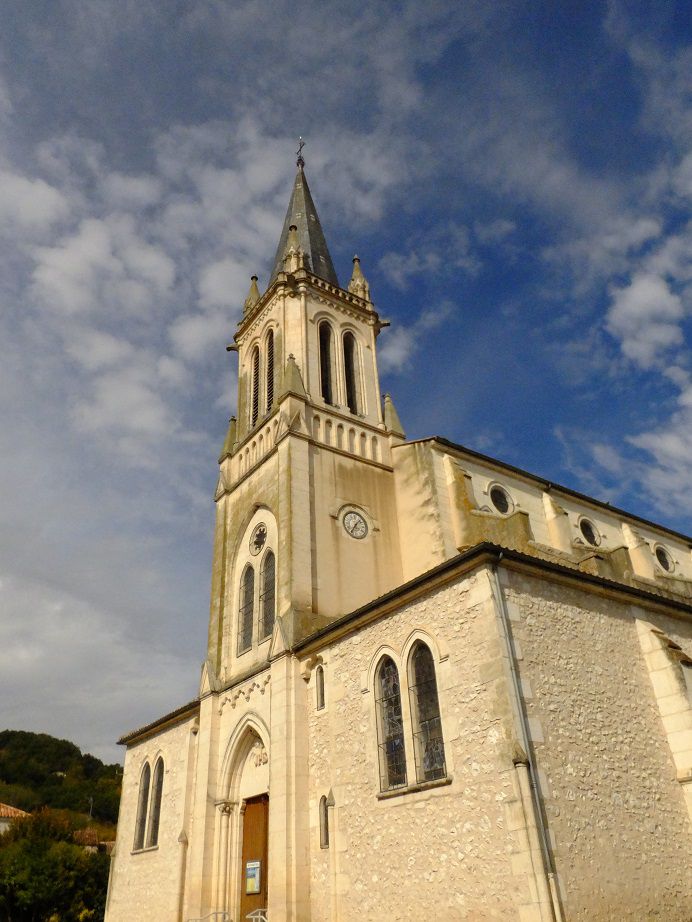If you find yourself near the end of the Dropt valley at the southeast edge of the Gironde department, not far from Duras, you may want to make brief stops in Pellegrue, Monségur, and an abbey in between.
Pellegrue
On a recent quiet Sunday, we head to this small village (pop. 1,029). We park near at the war memorial and walk about two blocks past traditional stone houses to Église Saint-André, a 12th-century Romanesque church. Notable is the doorway comprised of four arches, and a belltower on the the north side.
In the course of development of the church square, archaeologists found remains of a Gallo-Roman settlement, a Merovingian necropolis with monolithic limestone sarcophagi, and graves from the 11th century. They also discovered walls of a Benedictine priory and part of a medieval castle.
On our way downhill toward the town center, we pass a modern fountain, Font de Godemine, located in an ancient square.
The bastide is surrounded by the traditional covered arcades, and a large 19th-century iron market hall sits in the center. Wednesday is market day in Pellegrue.
 |
| Pellegrue’s war memorial |
 |
| Église Saint-André de Pellegrue |
 |
| Arched doorway of Église Saint-André de Pellegrue |
 |
| Font de Godemine in Pellegrue |
 |
| Pellegrue’s 19th-century covered market |
 |
| The clock belltower on Pellegrue’s tourism office |
Abbaey de Saint-Ferme
Wednesday would be a particularly good day to visit this area, because it’s also the day that guided visits are offered at the Abbaye de Sainte-Ferme, located about 10 minutes away on D16 toward Monségur.
Situated on the road to Compostelle, the abbey was founded by a Benedictine order of monks in the 12th century.
The large imposing Romanesque abbey, which has not been occupied by monks since 1770, contains carved capitals sculpted by les maîtres de Sainte-Ferme — the masters of Sainte Ferme — and an 18th-century fresco portraying justice.
Abbaye de Saint-Ferme is open for guided tours from 2:30-6 p.m. on Wednesdays, but visitors can enter the church and courtyard at any time.
 |
| Abbaye de Saint-Ferme |
 |
| Exterior detail of Abbaye de Saint-Ferme |
 |
| Entering the courtyard at Abbaye de Saint-Ferme |
 |
| Courtyard of Abbaye de Saint-Ferme |
 |
| Interior of the church at Abbaye de Saint-Ferme |
Monségur
After our stop at Saint-Ferme, we continue down the road to our next bastide: Monségur. Here, the town square is dominated by a big 19th-century iron-and-glass covered market, even larger than the one we saw an hour earlier in Pellegrue. (Friday is market day in Monségur.) The population here (1,600 in 2011) supports a nice variety of businesses and even a movie theater.
The name Monségur means “hill of safety.” Like many bastides, the town was founded by a charter granted by Eleanor of Provence, wife of Henry III of England/Duc d’Aquitaine during the English occupation of the area.
We take our obligatory peek inside the village church, Église Notre-Dame and then stop by the Tour du Gouverneur. The former governor’s residence contains pillars inscribed “ebrehim” and “brehim” — the meaning of these words is a mystery.
Each July since 1988 the town has hosted
Swing de Monśegur, a three-day swing jazz festival, which draws fans from all over France. Look for me there next summer.
 |
| Monségur’s large iron-and-glass covered market |
 |
| Covered arcade in Monségur |
 |
| Église Notre-Dame de Monségur |
 |
| Detail above the door at Église Notre-Dame de Monségur |
 |
| Colorful interior of Église Notre-Dame de Monségur |
 |
| Tour de Gouverneur à Monségur |

















































